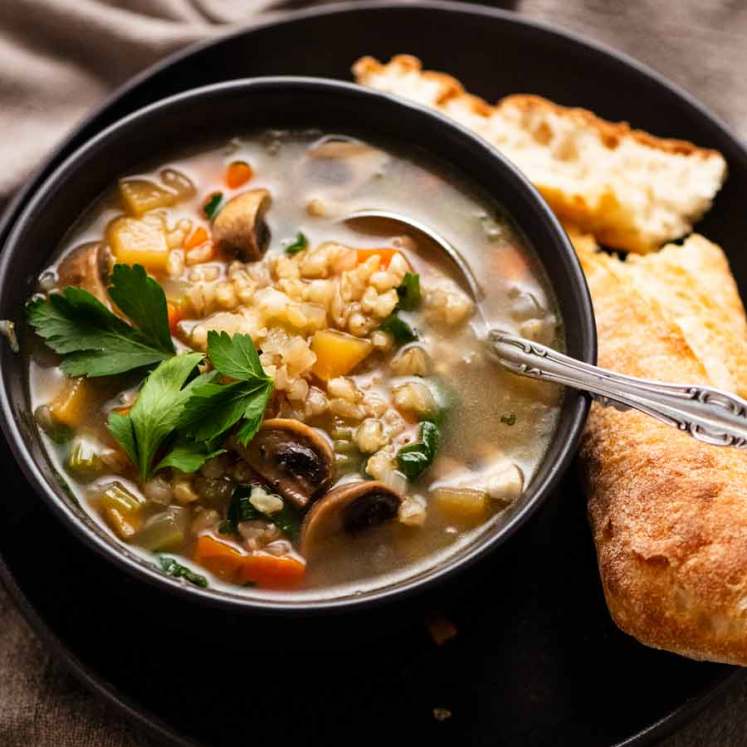If you think this Borek looks stunning, just wait until you taste it!! Flaky filo pastry is wrapped around a spiced lamb filling dotted with pine nuts and currants, then curled into a charming spiral. Borek is found in different guises and goes by various names – burek, bourekas, byrek etc. But the thing they all have in common? They’re all irresistible!
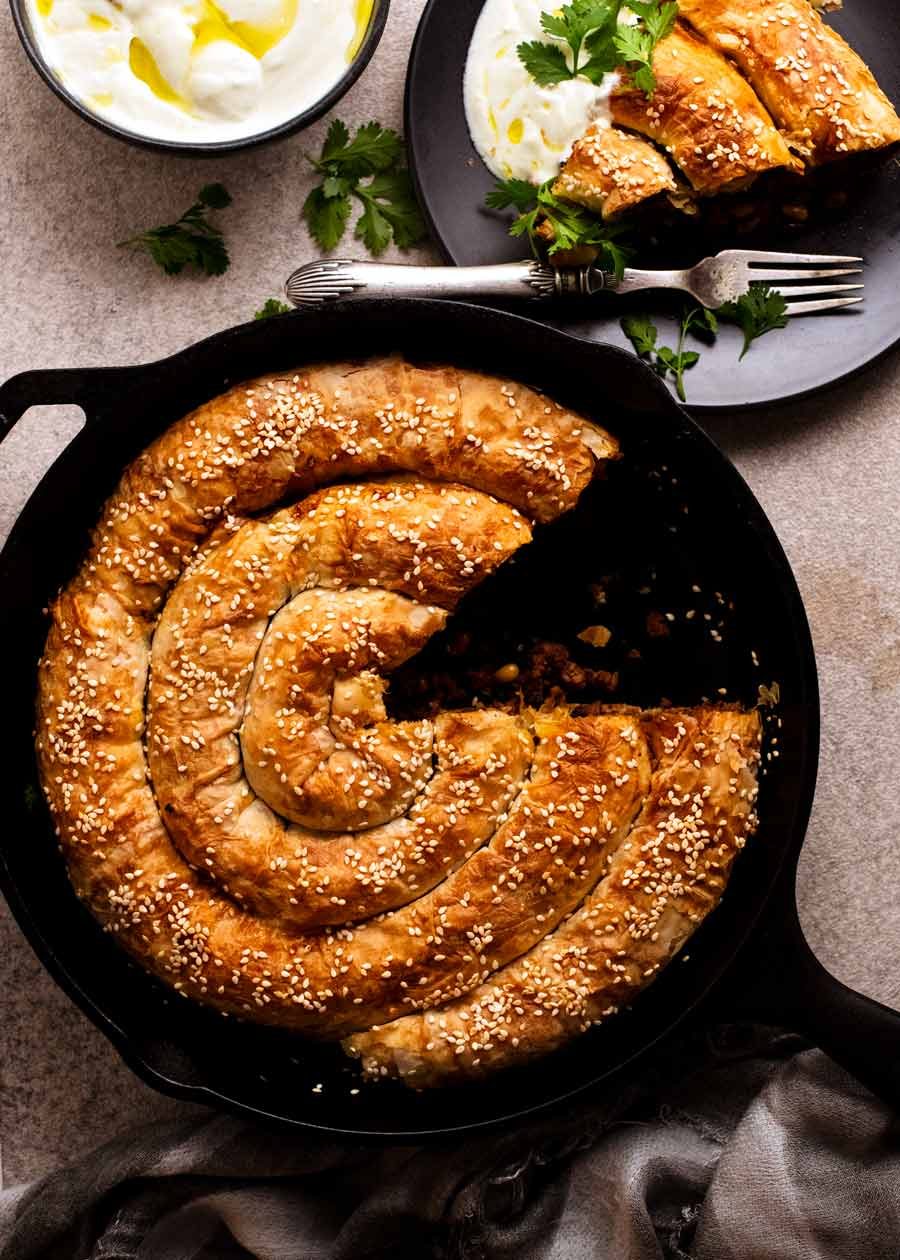
Lamb Borek
Savoury pastries are hard to beat. It explains why pretty much every nation on earth seems to boast at least one kind they’re fiercely proud of. Borek is a pastry that gets so much love it can be found in not one but a swathe of countries, spanning the Balkans and Eastern Europe, Greece and Turkey, all the way to Armenia and North Africa – the Borek Belt!
This deliciously flaky, baked pastry comes stuffed with different fillings. It might be meat, vegetables, potato, cheese or some combination. The shape also varies depending where it’s made. Sometimes they are flat pastries, sometimes a log shape and other times resemble a pie.
Sometimes they also come in a charmingly rustic coil shape which is what I’ve chosen today. The filling for this one is Spiced Lamb. It’s a mince filling flavoured with an intoxicating mix of gentle spices, and studded with currants for sweet pops as well as pine nuts for a little nutty crunch. The smell that will waft through your house as they bake will make your mouth water, and leave you desperately battling the urge to stop at one mouthful as you’re “just checking for seasoning” … !
If you make this and this happens to you, tell me in the comments below so I know it’s not just me!!! 😂



What you need to make Lamb Borek
We can break this down into following parts:
-
Spiced lamb filling with currants and pine nuts;
-
Borek pastry assembling; and
-
Lemon and yoghurt sauce
1. Lamb filling ingredients

Notes on a few of the ingredients:
-
Lamb mince – Lamb is a protein often favoured in the parts of the world Borek is found. The rich and distinct flavour of lamb with the spices gives this Borek its signature flavour that will transport you to the streets of Istanbul or Belgrade … like back in those days when we could freely travel!
Substitute with beef. The recipe will also work with chicken and turkey, but you’ll probably need to add a pinch more of each spice.
-
Tomato passata– Pureed, strained tomatoes, sometimes labelled Tomato Puree in the US (here’s a photo of Mutti Tomato Passata sold at Walmart). Readily available in Australian supermarkets nowadays, alongside pasta sauces.
-
Spice mix – All spices you can find at everyday super markets!
-
Currants – This can be substituted with raisins or sultanas. If using these, they are best chopped as they are a little larger than currants.
-
Pine nuts – These add that sweet, creamy nuttiness that you only get from pine nuts! Pistachios would make a nice alternative.
2. Borek assembling ingredients
Here’s what we need to assemble the borek:
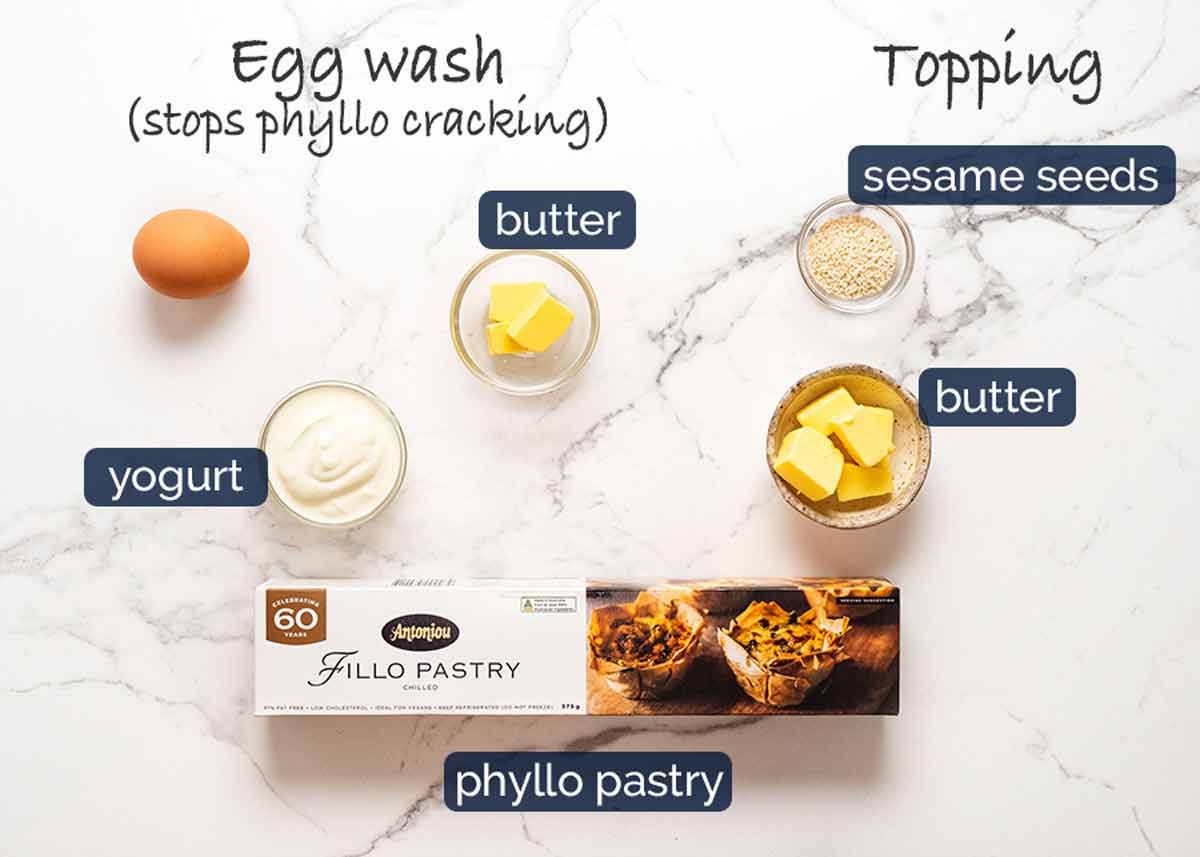
-
Filo pastry (aka phyllo pastry) – See below for tips on handling.
-
Yogurt egg wash – This is a mixture made with egg, butter and yoghurt that is brushed on each layer of filo to soften it so it doesn’t crack when rolled up into a coil. Having tried it with and without, even using a pliable refrigerated filo pastry (as opposed to the more brittle frozen-thawed variety), I can tell you that it’s absolutely necessary, it works, so do not skip it!
-
Topping – Butter for brushing to make the pastry golden, and sesame seeds for a traditional finish!
Filo pastry for borek (aka phyllo pastry)
Borek is made with filo pastry, the paper thin pastry that is mostly used layered to get the signature flakiness. Also known as phyllo pastry, it is used to make both savoury and sweet pastries in Mediterranean and Middle Eastern cuisines, such as Baklava and Spanakopita.
It comes frozen or fresh, in the fridge section of grocery stores. I recommend getting fresh filo. It’s more pliable and easier to work with. See below for more on this.

Tips for handling filo pastry
I know some people are a bit intimidated by the thought of working with filo pastry. It can be prone to breaking if not handled correctly. But if you follow a few simple steps, there’s nothing tricky about it at all!
-
Fridge (ie. fresh) filo pastry is easier to handle – It’s more pliable than frozen-then-thawed, so you don’t need to be as careful handling it. Find it in the fridge section of grocery stores, usually alongside fresh pasta;
-
If using frozen filo pastry – Thaw overnight in the fridge. Never try to speed up thawing by placing in a warm environment. It dries the pastry out and makes it brittle so it tends to shatter;
-
Take it out of the fridge 30 minutes beforehand – Whether using frozen thawed or fresh. Bringing it to room temperature makes it more pliable and therefore easier to handle;
-
Keep the phyllo pastry covered with a slightly damp tea towel to ensure it doesn’t dry out; and
-
Handle like tissue paper, ie. with fairy fingers. Don’t manhandle it like a slice of ham!
Part 3: Lemon Yoghurt Sauce
And lastly, here’s what we need for the lemon yoghurt sauce served with the borek:
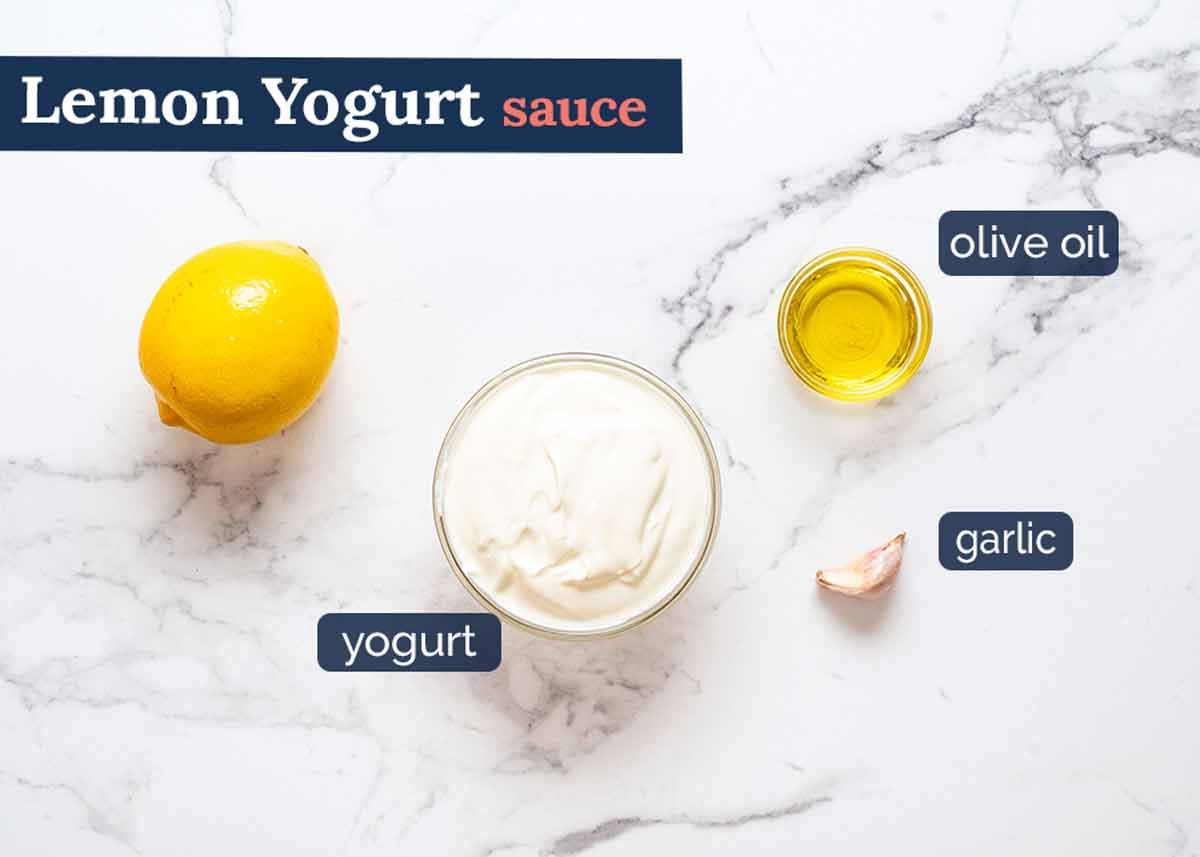
How to make Borek
This section is broken up into the following parts:
-
Making the spiced lamb filling;
-
Mixing the yoghurt wash that stops the filo pastry from cracking;
-
Rolling the lamb filled tubes;
-
Assembling and baking the borek; and
-
Eating! (The best part!)
Part 1: Filling
Start with the filling first so it has time to cool while you prepare the other components.
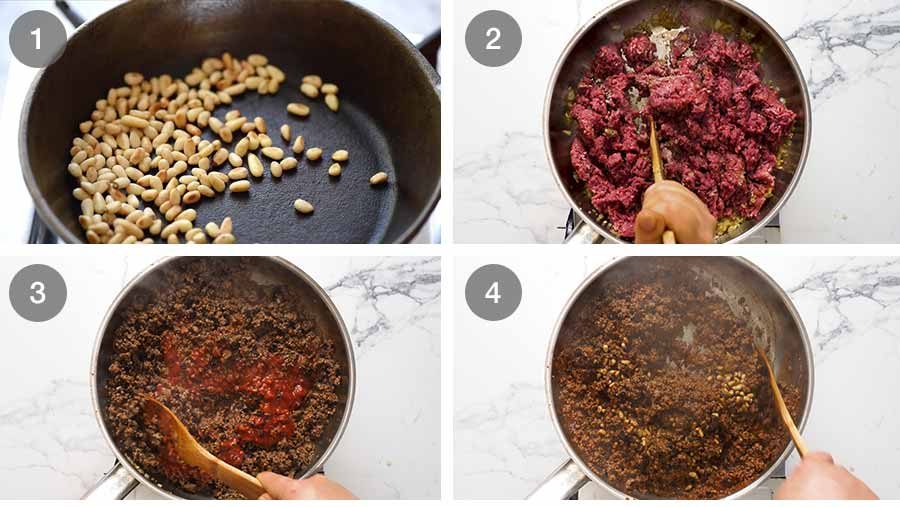
-
Toast the pine nuts in a skillet (no oil needed) over medium heat until it’s lightly golden. When ready, immediately remove the pine nuts from the skillet.
-
Cook lamb –Sauté the onion and garlic in a skillet over high heat. Then add the lamb and cook it, breaking it up as you go, until it changes from pink to brown.
-
Cook spices – Once the lamb is mostly brown, add the spices and prepare yourself for some amazing smells!!! Cooking off the spices is always a good thing where possible because it brings out the flavour.
-
Simmer then cool – Add the currants, pine nuts, tomato passata and water then give it a good stir. Cook on low for 5 minutes or until the liquid mostly reduces. The goal: A juicy filling that’s not watery, else it will soak the delicate filo pastry.
Cool – Once the filling is ready, remove the skillet from the stove and let it cool. Hot filling inside pastry will steam and make the pastry soggy, so cooling is essential!
While the pastry is cooking, start preparing the other components.
Part 2: Yoghurt wash for filo pastry
As mentioned above, a simple egg, yoghurt and butter mixture lightly brushed on the surface of the filo pastry will stop it from cracking when you roll and coil the pastry. You will still have a crispy top because we only brush the yoghurt between the layers of filo. Indeed we will brush the top with butter to make the surface nice and crispy!

-
Mix – Simply place the yoghurt, butter and egg in a small bowl or jug and mix to combine. The mixture will look curdled but this is normal.
-
Reheat if needed – The yoghurt wash will look a bit split and lumpy when the butter becomes cold. If it gets a bit thick to easily brush onto the delicate filo pastry, just microwave briefly to warm it so it loosens up.
Just warm, not hot. If it’s too hot, it “melts” the filo pastry, making it sticky and difficult to work with.
Part 3: Preparing filo layers

-
Prepare filo pastry – Unwrap and unroll the filo pastry. Peel off one layer and place on a work surface. Cover the remaining filo pastry with a damp, lightweight tea towel so it doesn’t dry out (unless you’re a speedy borek rolling master!).
-
Brush with yoghurt wash – Dip a pastry brush into the yoghurt wash, then flick it across the surface of the filo pastry. Place one hand on the filo pastry to hold it in place and use the other to lightly brush the yoghurt wash across the surface. You don’t need to be 100% thorough here, it’s not a painting competition! Just as long as the surface areas is mostly covered, that’s sufficient.
-
Repeat – Top with another sheet of filo pastry, then repeat the drizzle and flick with yoghurt wash, and brushing on the pastry.
-
Four layers of filo – Each Borek log needs 4 layers of filo pastry. Brush the yoghurt wash between each layer, but don’t brush the final layer.
Part 4: Fill and roll

-
Fill – Place 1/3 of the lamb mixture across the bottom of the filo pastry, using a butter knife to shape it and push in pesky runaway bits.
-
Roll – Now roll up the filo pastry into a log. It doesn’t need to be super tight. In fact, it’s supposed to be fairly loose. But the looser the roll is, the harder it is to handle when moving/coiling. So aim for something in between!
-
A tip for rolling: A kitchen knife, ruler or similar long and thin object is helpful to lift the long edge of the filo pastry to start the rolling. You’ll see me using a knife in the recipe video below.
-
Make three rolls total – Repeat the process of the filo egg wash layering > filling > roll to make 3 rolls in total.
Now, spiral-forming time!
Part 4: Making the Borek spiral
The trick to easily transfer the assembled Borek spiral into the baking vessel is to assemble it on paper and slide it in. So we’ll form the shape on a sheet of baking paper.
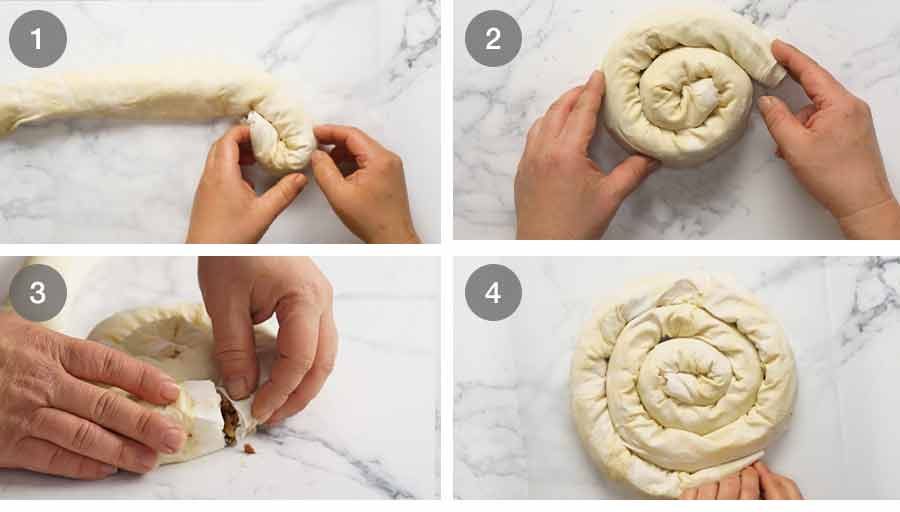
-
Spiral – Place one Borek log on a sheet of baking / parchment paper.
-
Roll into spiral – Roll the borek into a fairly loose coil that’s touching but not squished.
Look Ma, the filo pastry didn’t crack! That’s the yoghurt wash at work! Wa-hey!
-
Join on another log – Get another log and attach it to the end of the first one to keep extending the spiral. Do this by stuffing the end of one roll inside the end of the other. Using a bit of yoghurt wash to help them adhere. Then continue wrapping it around the existing spiral to continue. Repeat with the 3rd log.
-
Finish spiral – Once you’ve done the the third log and finished your spiral, stand back and admire your work. Now, it’s time to bake!
Part 4: Baking the Borek

-
Skillet for baking (or other dish) – My 26cm / 10.5″ cast iron skillet is the perfect size to fill with a Borek spiral made with 3 sheets of filo pastry. Any similar sized round baking dish such as a tart pan or large pie dish will work just fine.
You can even free-form it on a baking tray because Borek will not spread when baking.
Whatever you use for your baking vessel, brush it with melted butter so the borek doesn’t stick. It would be a crying shame if the pastry gets stuck to the skillet after all that work!!
-
Transfer to skillet – Use the paper to pick up the Borek and place it in the skillet. Then use your hands to slide the paper out from underneath.
I tried a few methods for the transferring move, and this was by far the easiest. Don’t try assembling the spiral in the skillet – the delicate pastry will catch and tear on the oiled skillet as you slide it around to create the spiral.
For the record, I also tried making one thick log instead of a spiral. This works just fine and looks impressive when you’re making it. But it does require a deft touch when rolling. You’d think it’s easier than a spiral but actually it’s harder because filo pastry is quite delicate!
-
Butter and sesame seeds – Brush the Borek surface with cooled melted butter, then sprinkle with sesame seeds.
-
Bake 40 minutes– Bake for 40 minutes until golden. Remember the filling is cooked so we’re just heating it through and cooking the pastry, so it’s done when the pastry has bronzed.

Part 5: Serving borek

-
Slice – To serve, cut wedges like a pie. It looks so impressive when you pull a slice out to reveal the cross section with the juicy, spiced lamb filling. And the smell!!! And the taste! The world will stop turning for a moment. There may be guest applause. No, there will be applause. And you will totally deserve the ovation, because look at that thing. So lap it up!
-
Yoghurt sauce – This lamb Borek recipes comes with a simple Lemon Yoghurt Sauce which compliments the spicing of the lamb filling beautifully. Made simply with yoghurt, lemon, garlic and extra virgin olive oil, just mix and set aside for 20 minutes to let the flavours meld. Then let people help themselves!

What to serve with Borek
Borek is good served hot, warm or even at room temperature. It makes a delicious snack or picnic food, but of course can happily star as a meal in itself!
For this rich, meat-filled pastry, a fresh salad with crisp vegetables makes an ideal partner. Given the provenance of Borek, think Mediterranean or Middle Eastern and you can’t go wrong. Here are some on-theme suggestions, as well as some great all-rounders that work with “everything”:
Sides for Borek
Love to know if you try this…. tell me if you nail the spiral!!– Nagi x
Watch how to make it
Hungry for more? Subscribe to my newsletter and follow along on Facebook, Pinterest and Instagram for all of the latest updates.

Borek
#wprm-recipe-rating-0 .wprm-rating-star.wprm-rating-star-full svg * { fill: #343434; }#wprm-recipe-rating-0 .wprm-rating-star.wprm-rating-star-33 svg * { fill: url(#wprm-recipe-rating-0-33); }#wprm-recipe-rating-0 .wprm-rating-star.wprm-rating-star-50 svg * { fill: url(#wprm-recipe-rating-0-50); }#wprm-recipe-rating-0 .wprm-rating-star.wprm-rating-star-66 svg * { fill: url(#wprm-recipe-rating-0-66); }linearGradient#wprm-recipe-rating-0-33 stop { stop-color: #343434; }linearGradient#wprm-recipe-rating-0-50 stop { stop-color: #343434; }linearGradient#wprm-recipe-rating-0-66 stop { stop-color: #343434; }
Ingredients
Lamb Filling:
- 2tbspolive oil
- 1onion, finely diced (1 small or 1/2 a large)
- 2garlic cloves, finely minced
- 600g / 1.2 lblamb mince(ie. ground lamb, or substitute beef)
- 1 1/2tspground cumin
- 3/4tspeach of ground coriander, cinnamon, paprika(plain or sweet paprika)
- 1/2tspallspice(sub mixed spice or similar spice mix)
- 1/2tspcayenne pepper or Turkish red pepper flakes(reduce for less spicy)
- 1/2tspblack pepper
- 1 1/4tspsalt(cooking / kosher salt, OR 1 tsp table salt)
- 1/3cupcurrants(or raisins or sultanas, roughly chopped)
- 1/3cuppine nuts, toasted (Note 1)
- 1cuptomato passata(tomato puree in US, Note 2)
- 1/4cupwater
Yogurt wash for filo (stops cracking):
- 1egg
- 2tbspplain yogurt
- 30g / 2 tbspunsalted butter, melted
Pastry:
- 12sheets phyllo pastry(Note 3)
- 25g / 1 1/2 tbspunsalted butter, melted and cooled
- White sesame seeds(optional)
Lemon Yogurt Sauce:
- 1cupplain yogurt
- 1/4tspgarlic, finely grated
- 1tbsplemon juice
- 1tbspextra virgin olive oil
- Pinchof salt
Instructions
Lamb filling:
-
Cook onion and garlic: Heat oil on high in a large skillet. Cook onion and garlic for 2 to 3 minutes until softened.
-
Cook lamb and spices: Add lamb and cook lamb, breaking it up as you go, until mostly changes from pink to brown. Then add all the spices and cook for 1 minute.
-
Simmer: Add tomato passata and water, mix. Then add currants and pine nuts. Bring to simmer, turn heat down to medium low and cook until liquid reduces so the mixture is moist but not watery.
-
Cool: Remove from stove and allow to fully cool before using.
Lemon Yogurt Sauce:
-
Mix ingredients in a small bowl. Set aside for at least 20 minutes.
Rolling tubes:
-
Preheat oven to 200°C / 390°F (180°C fan).
-
Yogurt Wash (Note 4): Mix ingredients until combined.
-
Prepare filo: Open the filo pastry packet and unroll the pastry. Peel one layer off and place on a piece of baking / parchment paper. Cover the remainder with a lightweight damp tea towel to stop them from drying out.
-
Brush with yogurt wash: Drizzle / flick yogurt wash across filo using a pastry brush. Then lightly brush across surface in a thin layer. You don’t need to cover every inch, just mostly cover the surface.
-
Layer filo: Top with another filo pastry sheet, and brush this too with yogurt wash. Then repeat so you have 4 layers in total, but do not brush the last (4th) filo with yogurt wash once laid.
-
Fill and roll: Place 1/3 of the Lamb filling along the bottom edge. Using the aid of a long kitchen knife to get it started, roll up into a log. Doesn’t need to be tight and don’t try, as the pastry is delicate.
-
Make 3 logs: Repeat to make 3 logs, using all the Filling.
Shape into spiral and bake:
-
Spiral: Take one log and place on a piece of baking / parchment paper. Coil into a spiral. Join a second log to the first by stuffing the ends inside each other, using yogurt wash to adhere. Continue forming the spiral. Log sides should be in contact but not tightly squished.
-
Transfer to baking vessel: Brush a 26cm / 10.5″ cast iron skillet (Note 5) with melted butter. Then use the paper to transfer the borek into the skillet, and slide the paper out.
-
Brush with butter: Brush the top with butter, sprinkle with sesame seeds.
-
Bake for 40 minutes or until pastry is golden.
-
Serve! Remove from oven. Cut wedges like pie. Serve with Lemon Yogurt Sauce!
Recipe Notes:
Nutrition Information:
Life of Dozer
This is how we celebrate birthdays at Team RecipeTin during lockdown – with goodie bags delivered to each team member for a virtual Zoom birthday party!


Yes Dozer, the bag contains cake. (And cheese and crackers and champers and party poppers and party hats and sparklers and lolly bags!!!)












